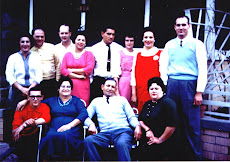
Point Cadet was a tight-knit, largely Catholic community. If you lived on the Point, you probably were a member of St. Michael’s Parish. You may even have gone to St. Michael’s grade school.
St. Michael’s was started as a mission to serve the people of the Point in 1917 (or 1907 depending on which source you go by).
When most people think of St. Michael’s, they think of the modern seashell-domed fisherman’s church, prominent in this blog’s header. That church, though it became the Point’s most distinctive landmark, was only built in 1964. The original St. Michael’s church was housed in a wooden structure down on First Street. It burned in 1969.
My grandparents and two aunts married there. Almost everyone in my family, myself included, was christened at St. Michael's. My mother, her siblings and a couple of my cousins went to St. Michael’s school and made their First Communions and confirmations in the parish.
Though I largely lived in other parishes, we went to Mass fairly regularly at St. Michael's since we spent all our holidays and a lot of weekends at my grandparents’ house. As a kid, I was scared of the long Cubist-style stained glass windows depicting the apostles.
And we always patronized the St. Michael’s bazaars, the fund raisers held to help support the church and school.
St. Michael’s bazaars were great multi-generational social occasions – you saw second, third, fourth and even fifth cousins as well as all your friends and your parents’ and grandparents’ friends. If the bazaar fell during high school sorority rush week, the pledges from Biloxi High and Sacred Heart could get their 300 signatures on a pillow case or whatever task the seniors assigned to them. The pledges had to wear tacky outdated clothes and unwashed hair. Oh, what teenage girls will do to be accepted by their peers.
You could take a chance on the cake walk. Purchase cuttings of heirloom plants. Stuff your face with candied apples and cotton candy. Listen to music. Play bingo. Or just people watch.
And you could always get a good plate dinner, usually seafood or chicken sausage gumbo with a scoop of potato salad floating in it. Or my personal favorite, baked chicken with dirty rice dressing.
And you could always get a good plate dinner, usually seafood or chicken sausage gumbo with a scoop of potato salad floating in it. Or my personal favorite, baked chicken with dirty rice dressing.
This flavorful, well-spiced dish, featuring the “holy trinity” of Cajun cooking – celery, bell pepper and onion -- is a great accompaniment to often-bland baked chicken. The “dirt” is actually meat, chopped chicken livers and gizzards and/or ground sausage or ground beef. Wish I had a big plate of it right now. This recipe makes a lot, but then you’re going to want a lot.
Dirty Rice Dressing
¼ cup cooking oil
½ chicken liver, parboiled and chopped fine
1 lb of chicken gizzards, parboiled and chopped fine
3 lb of ground beef or pork sausage
3 large onions, chopped fine
1 cup chopped celery
1 bunch green onions, chopped
1 bunch parsley, chopped
2 medium bell peppers, chopped
3 cloves chopped garlic
4-6 cups cooked rice
Salt and pepper to taste.
Saute onions, celery, bell pepper and garlic in oil. Add gizzards and liver. Cook about 30 minutes. Add beef (or sausage), green onions, parsley and salt and pepper. Cook 30 minutes more. Mix in cooked rice. Stir thoroughly. May use Kitchen Bouquet to achieve desired color.
Photo: All of the Soljan children, including Uncle Raymond shown here in the late 1940s, made their First Communions and confirmations at St. Michael's.



